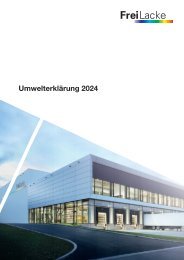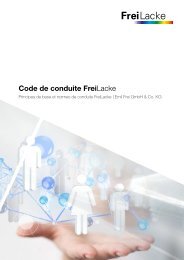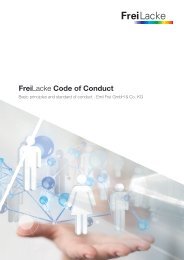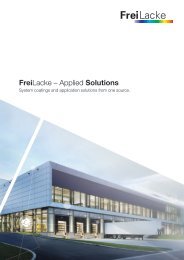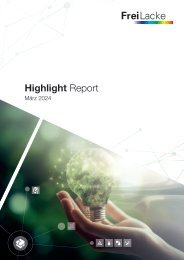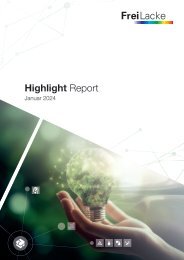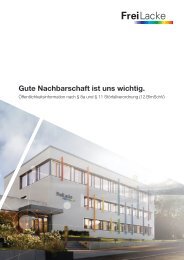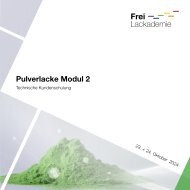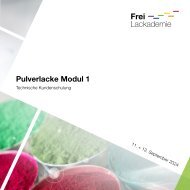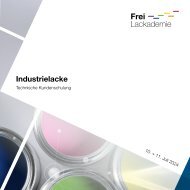Anodized effects with powder coating_engl
You also want an ePaper? Increase the reach of your titles
YUMPU automatically turns print PDFs into web optimized ePapers that Google loves.
<strong>Anodized</strong> <strong>effects</strong> <strong>with</strong> <strong>powder</strong> <strong>coating</strong><br />
Solutions for the highest demands and design
<strong>Anodized</strong> <strong>effects</strong> <strong>with</strong> <strong>powder</strong> <strong>coating</strong>s<br />
FreiLacke has worked together <strong>with</strong> pigment manufacturer Merck KGaA (Darmstadt, Germany) to develop <strong>powder</strong> <strong>coating</strong><br />
series PP7001K, a new <strong>coating</strong> system <strong>with</strong> anodized colours. The established colours from the anodizing of aluminium<br />
served as the basis for the colour shades. As the <strong>coating</strong>s are based on polyester, components <strong>with</strong> this <strong>powder</strong> <strong>coating</strong><br />
are particularly suitable for outdoor applications.<br />
To protect aluminium against corrosion, a protective oxide layer is produced by anodic oxidation. This anodized layer is very<br />
hard and scratch-resistant; however, it is also very brittle, which is why work-pieces must be fully shaped before they are<br />
anodized.<br />
Furthermore, the process costs of the anodizing process are relatively high. This is why there have been frequent attempts<br />
to replace the anodized layer <strong>with</strong> a <strong>powder</strong> <strong>coating</strong>. Visually, the oxide layer has a very matt, velvety surface. The colour of<br />
the oxide layer can be changed using colourising metal salts in the electrolyte or by using organic or inorganic dyes.<br />
General Product Description<br />
A pure polyester-primid system was selected as the matrix<br />
material to simulate the anodized colours. Matting of<br />
pure polyester-primid <strong>powder</strong> <strong>coating</strong>s has always been<br />
tricky because the addition of waxes or fillers produces a<br />
gloss level of only approx. 45 GU (angle 60°).<br />
To achieve a gloss level of 15-25 GU, a special method<br />
must be used – the dry-blending technique. This<br />
involves mixing two <strong>powder</strong> <strong>coating</strong>s together. The two<br />
components mainly differ in their reactivity. During curing,<br />
a microstructure develops due to the different reaction<br />
rates of the two components. This leads to diffuse lightscattering<br />
on the surface of the <strong>coating</strong>, thus producing<br />
a matt effect. The challenge here is to produce a surface<br />
appearance that, in spite of the microstructure, is<br />
smooth, well-levelled and virtually pixel-free. The polyester<br />
dry-blend base was developed further by FreiLacke<br />
and was chosen for the anodised colour shades thanks<br />
to its velvety surface.
Manufacture<br />
The colour shades were all produced <strong>with</strong> the bonding process. A very high-quality pearlescent pigment system was<br />
chosen for this product. The advantage of these pigments over aluminium bronzes is their high abrasive resistance and<br />
resistance to weathering. The basic pigment system was formulated in collaboration <strong>with</strong> Merck KGaA (Darmstadt) and<br />
optimised by FreiLacke.<br />
The manufacturing process for the metallic <strong>powder</strong> <strong>coating</strong>s was also optimised for this application. As the pearlescent pigments<br />
are liable to disintegrate during the bonding process, a special gentle method was developed that reduces pigment<br />
damage.<br />
Properties of the <strong>powder</strong> <strong>coating</strong> system<br />
The colour shades were matched to those of the EURAS colour fans. The gloss level of the colour shades lies between<br />
18 and 29 GU (angle 60°). They have a homogeneous, matt, velvety surface appearance that closely matches that of the<br />
EURAS fans.<br />
The optimum baking conditions for this product are 10 minutes and an object temperature of 180 °C. The system exhibits<br />
high flexibility against subsequent deformation, both on steel and on aluminium (see Figure 1 and Figure 2).<br />
Since the pigmentation is purely pearlescent, abrasive wear does not produce black discolouration, which makes it suitable<br />
for use on office furniture. The colour shades are also highly resistant to chemicals and cleaning agents.<br />
Resistance to weathering (Figure 3) lies at the standard GSB<br />
level (300 h / >50 % residual gloss), which means that it can be<br />
used in industrial outdoor applications.<br />
Figure 1: Mechanical stability on aluminium<br />
Figure 3: QUV-B test using the GSB method<br />
Powder <strong>coating</strong>s <strong>with</strong> the anodized effect are available in a 25<br />
kg box or 2.5 kg minipack ex warehouse:<br />
Figure 2: Mechanical stability on steel<br />
ANODIZED SILVER<br />
SLIGHTLY BRONZE<br />
LIGHT BRONZE<br />
MID BRONZE<br />
DARK BRONZE<br />
ANODIZED BLACK<br />
PP7001KE1870<br />
PP7001KE1871<br />
PP7001KE1872<br />
PP7001KE1873<br />
PP7001KE1874<br />
PP7001CE1875
Wheels<br />
Vehicle construction<br />
Mechanical engineering<br />
Job coaters<br />
Functional furniture and storage technology<br />
Construction and sanitary<br />
FreiLacke | Emil Frei GmbH & Co. KG<br />
Am Bahnhof 6<br />
78199 Bräunlingen/Döggingen<br />
Germany<br />
Phone +49 7707 151-0<br />
Fax +49 7707 151-238<br />
info@freilacke.de<br />
www.freilacke.com




